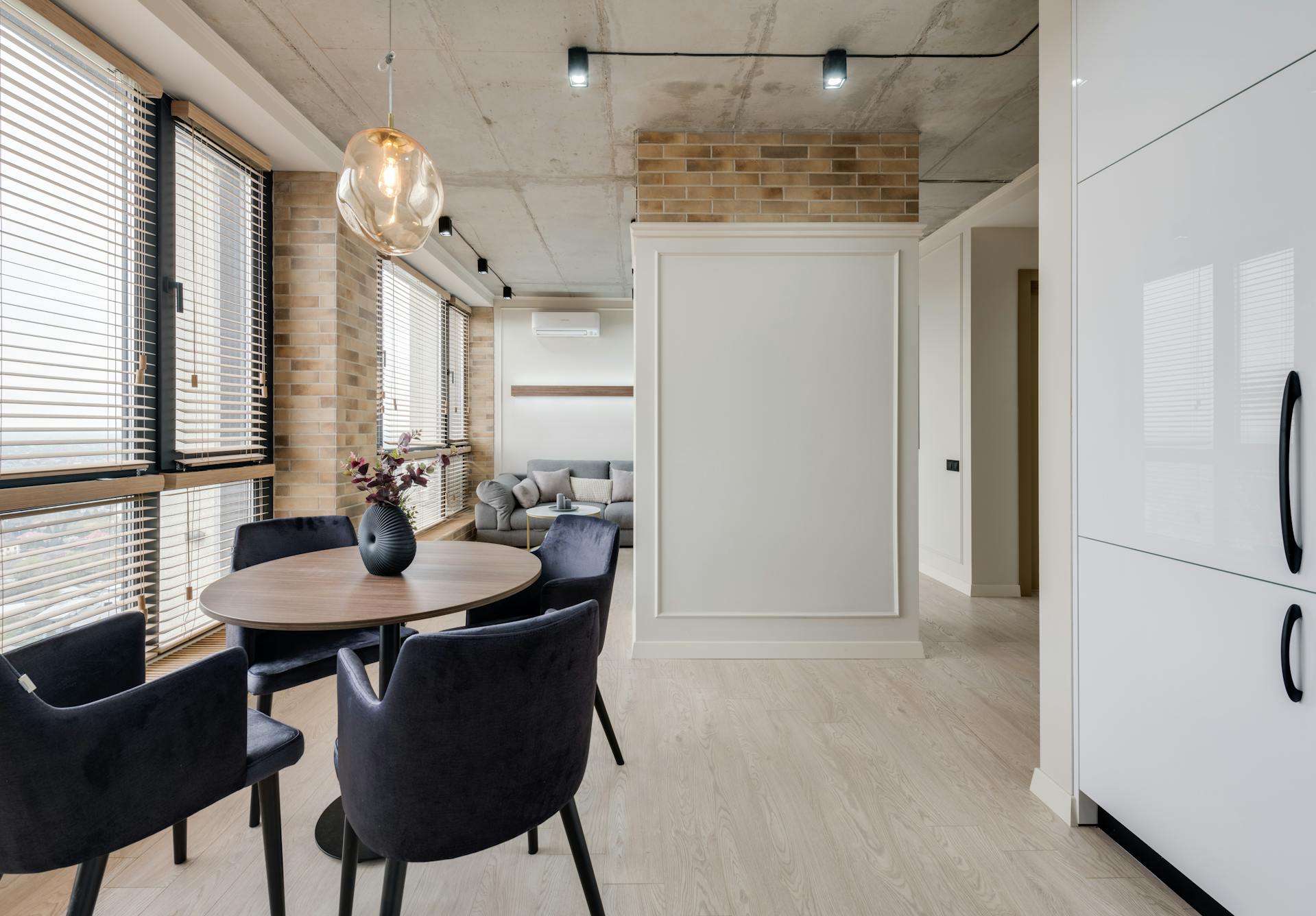Creating the Perfect Dining Space: A Modern Approach to Interior Design
The dining room has evolved from a formal, rarely-used space into the vibrant heart of contemporary homes. No longer reserved exclusively for special occasions, today’s dining areas serve multiple purposes—family meal headquarters, remote work stations, homework hubs, and social gathering spaces that bring people together in meaningful ways.
This transformation reflects broader shifts in how we live, work, and connect with others. Open-plan layouts have blurred traditional room boundaries, while changing lifestyles demand spaces that adapt to varied needs throughout the day. Understanding how to create a dining environment that balances functionality with aesthetic appeal has become essential for homeowners seeking to maximize both the utility and beauty of their living spaces.
The Multifunctional Dining Room Reality
Modern dining rooms must work harder than ever before, accommodating diverse activities while maintaining their primary purpose as gathering spaces for meals.
Beyond Traditional Dining
The average dining table now hosts morning coffee while checking emails, afternoon homework sessions with children, evening family dinners, and weekend brunches with friends. This intensive, varied use requires thoughtful design that supports multiple functions without compromising comfort or style.
Smart homeowners recognize this reality and plan accordingly. Durable, easy-to-clean surfaces become priorities. Storage solutions for everything from work laptops to craft supplies need integration into the design. Lighting must adapt from bright task illumination for work to softer, ambient settings for intimate dinners.
The Open-Plan Challenge
In homes with open-plan layouts, dining areas must coordinate with adjacent kitchen and living spaces while maintaining distinct identity. This requires careful consideration of how furniture, colors, and lighting define the dining zone without creating jarring transitions or visual clutter.
Strategic rug placement, distinct lighting fixtures, and thoughtful furniture arrangement help establish clear boundaries while preserving the flow and connectivity that make open-plan living appealing.
Current Design Movements Shaping Dining Spaces
Staying informed about evolving design trends for dining rooms helps homeowners create spaces that feel both current and timeless, avoiding dated looks that quickly feel stale.
Sustainable and Natural Materials
Environmental consciousness increasingly influences interior design choices. Reclaimed wood tables, natural fiber textiles, and sustainably sourced furniture appeal to homeowners seeking to reduce environmental impact while creating warm, organic spaces.
These materials bring inherent beauty—the unique grain patterns of reclaimed wood, the textural interest of jute or linen, and the honest simplicity of natural finishes. Beyond aesthetic appeal, sustainable choices often prove more durable and age more gracefully than synthetic alternatives.
Curved and Organic Shapes
After years of sharp angles and geometric minimalism, softer, more organic forms are gaining prominence. Round and oval dining tables, curved-back chairs, and flowing pendant lights create welcoming, approachable environments that feel less formal and more conducive to relaxed conversation.
These gentler shapes prove particularly effective in smaller spaces, eliminating sharp corners that can make movement awkward while creating better traffic flow around the dining area.
Textural Layering
Contemporary design embraces texture as a key element for creating visual interest and depth. Combining materials with different tactile qualities—smooth marble with rough linen, polished metal with woven rattan, glossy ceramics with matte wood—produces sophisticated, multi-dimensional spaces.
This layering approach works especially well in neutral color schemes, where texture prevents spaces from feeling flat or monotonous while maintaining cohesive, calming atmospheres.
Statement Lighting as Focal Points
Dining room lighting has evolved from purely functional to sculptural centerpiece. Bold pendant lights, dramatic chandeliers, or clusters of artistic fixtures draw the eye upward, adding personality and defining the dining zone within larger spaces.
These statement pieces serve dual purposes—providing essential task lighting for meals while functioning as artwork that expresses personal style. The right fixture can transform an ordinary dining area into something memorable and distinctive.
Color Psychology and Palette Selection
Color profoundly affects how dining spaces feel and function, influencing everything from appetite to conversation quality.
Warm Neutrals for Versatility
Earth tones, warm grays, and soft beiges create adaptable backgrounds that work across seasons and accommodate changing decor accents. These colors provide sophistication without overwhelming, allowing furniture, artwork, and dining accessories to take center stage.
Warm neutrals also prove remarkably practical, disguising minor marks and wear while creating cozy, inviting atmospheres that encourage lingering over meals and conversation.
Strategic Color Accents
While neutral foundations offer flexibility, strategic color introduction through accessories, artwork, or feature walls adds personality and visual interest. Deep jewel tones like emerald, sapphire, or burgundy create drama and elegance, while softer pastels introduce subtle charm without dominating.
The beauty of accent colors lies in their changeability—swapping cushions, artwork, or table linens allows seasonal refreshes and style evolution without major renovation.
Monochromatic Sophistication
Single-color schemes using various shades, tints, and tones of one hue create cohesive, sophisticated spaces with inherent visual harmony. This approach proves particularly effective in smaller dining areas, where too many competing colors might feel chaotic.
Texture becomes especially important in monochromatic schemes, providing visual variety that prevents spaces from feeling flat despite limited color range.
Furniture Selection Strategies
Choosing appropriate dining furniture requires balancing aesthetic preferences with practical considerations about size, comfort, and durability.
Table Size and Shape Considerations
Table selection fundamentally shapes how the dining space functions and feels. Rectangular tables suit longer, narrower rooms and accommodate more guests when needed, while round or oval tables encourage conversation by eliminating hierarchy and allowing everyone to see each other easily.
Square tables work well in compact spaces or when creating intimate dining nooks within larger rooms. Extendable options provide flexibility, accommodating everyday use and special occasions requiring additional capacity.
Allow at least 90-120cm between the table edge and walls or other furniture to ensure comfortable chair movement. Each diner needs approximately 60cm of table width for comfortable dining without feeling cramped.
Seating Comfort and Style
Dining chairs significantly impact both comfort and aesthetic. Upholstered seats increase comfort for long meals but require more maintenance than wood or metal alternatives. Mix-and-match approaches—using different chairs at each end or alternating styles—add visual interest while maintaining cohesion through shared colors or materials.
Consider seat height carefully, ensuring proper proportion with your table. Standard dining tables stand 75cm high, requiring chairs with seat heights around 45cm for comfortable dining posture.
Benches offer space-saving alternatives for one table side, accommodating more people when needed while tucking neatly under tables when not in use. They work particularly well in family-friendly dining spaces or casual, contemporary designs.
Storage Integration
Built-in or standalone storage pieces like sideboards, buffets, or china cabinets provide essential functionality while contributing to the room’s design. These pieces house dining essentials—linens, serving dishes, glassware—keeping them accessible yet organized.
Modern interpretations of traditional storage furniture blend functionality with contemporary aesthetics, offering cleaner lines and varied materials that suit current design sensibilities while providing timeless utility.
Lighting Layers for Ambiance and Function
Effective dining room lighting combines multiple sources at different levels to create flexible, functional spaces that adapt to various needs and moods.
Task Lighting Essentials
Primary overhead lighting—typically a chandelier or pendant fixture centered over the dining table—provides necessary illumination for meals and other table activities. Position fixtures 75-90cm above the table surface to provide adequate light without obstructing sight lines across the table.
Dimmer switches prove invaluable, allowing light level adjustment from bright task lighting for homework or work activities to softer, romantic illumination for intimate dinners.
Ambient and Accent Lighting
Wall sconces, uplighting, or recessed ceiling lights create ambient illumination that reduces harsh shadows while establishing overall room brightness. These secondary sources prevent the dining area from feeling like a spotlight in an otherwise dark room.
Accent lighting highlights artwork, architectural features, or decorative elements, adding depth and visual interest. Display cabinet lighting or picture lights draw attention to treasured pieces while contributing to overall ambiance.
Natural Light Optimization
Maximize natural light through thoughtful window treatment choices. Sheer curtains or light-filtering shades provide privacy while allowing daylight to brighten the space. Mirrors strategically placed opposite windows amplify natural light, making rooms feel larger and more inviting.
Consider how natural light changes throughout the day and seasons, ensuring your artificial lighting plan compensates during darker periods while complementing rather than competing with abundant daylight.
Creating Cohesion in Open-Plan Spaces
When dining areas share space with kitchens or living rooms, establishing visual connections while maintaining distinct zones requires careful planning.
Consistent Design Language
Carry design elements—colors, materials, or style motifs—across connected spaces to create flow and unity. This doesn’t mean everything must match perfectly; rather, thoughtful repetition of key elements ties spaces together visually.
For example, if your kitchen features brass hardware, incorporate brass accents in dining room lighting or decor. Wood tones from living room furniture might echo in dining chairs or table selection.
Defined Yet Connected Zones
Area rugs effectively define dining spaces within open plans, anchoring furniture groupings while adding warmth and sound absorption. Choose rugs large enough to accommodate the table and chairs fully, even when pulled out—typically extending at least 60cm beyond the table on all sides.
Distinct lighting fixtures also establish clear zones. While maintaining style consistency with adjacent areas, a statement dining room pendant clearly demarks the eating space from surrounding areas.
Furniture Arrangement for Flow
Consider traffic patterns when arranging furniture, ensuring clear pathways between kitchen, dining, and living zones. Avoid creating obstacles that force awkward navigation or interrupt conversation flow between connected spaces.
Furniture placement should facilitate natural movement while creating subtle barriers that psychologically separate different functional zones without physical walls.
Personalizing Your Dining Space
Beyond following design principles and trends, successful dining rooms reflect the personalities and lifestyles of those who use them.
Meaningful Decor and Artwork
Display pieces that tell your story—family photographs, travel mementos, collections you’ve curated, or artwork you love. These personal touches transform generic dining spaces into rooms with character and meaning that reflect your unique journey and interests.
Gallery walls, floating shelves, or display cabinets provide opportunities to showcase treasured items while adding visual interest and conversation starters for guests.
Reflecting Your Entertaining Style
Your dining room should align with how you actually live and entertain. Formal entertainers might prioritize elegant place settings and sophisticated ambiance, while casual hosts might emphasize comfort, durability, and laid-back aesthetics.
Be honest about your lifestyle rather than creating a space that serves an idealized version of dining you rarely practice. A room you actually use and enjoy beats a beautiful space that feels too precious for everyday life.
Seasonal Flexibility
Design your dining space with enough versatility to accommodate seasonal changes and holiday celebrations. Neutral foundations allow easy transformation through seasonal textiles, table decor, and accent pieces that reflect different times of year.
This flexibility keeps your dining room feeling fresh and responsive to changing moods and occasions without requiring major renovation or investment.
Practical Maintenance Considerations
Beautiful design means little if materials and finishes can’t withstand real-world use, especially in busy family homes.
Durable Surface Selections
Choose table finishes that balance aesthetics with practicality. While high-gloss lacquers look stunning, they show every fingerprint and scratch. Oil-finished wood develops character as it ages but requires periodic maintenance. Sealed surfaces offer protection with minimal upkeep.
For families with young children, consider tempered glass, laminate, or stone surfaces that resist staining, scratching, and moisture damage while remaining easy to clean.
Fabric Choices for Upholstery
If selecting upholstered dining chairs, choose performance fabrics treated for stain resistance, or consider leather and vinyl alternatives that wipe clean easily. Removable, washable slipcovers offer another practical option for maintaining fresh appearance despite inevitable spills and wear.
Light colors create airy, sophisticated looks but show soil quickly. Darker shades or patterns with visual texture hide minor stains better, reducing maintenance stress in high-use dining areas.
Flooring That Withstands Traffic
Dining areas experience significant foot traffic and potential spills from food and drink. Hard surfaces like tile, luxury vinyl, engineered wood, or sealed hardwood offer durability and easy cleaning. Area rugs add comfort and sound absorption but choose washable or professionally cleanable options for areas prone to spills.
Frequently Asked Questions
How do I choose the right size dining table for my space?
Measure your room carefully, ensuring at least 90-120cm between the table edge and walls or other furniture for comfortable movement. For everyday dining, allow 60cm of table width per person. A family of four needs a minimum 120cm x 75cm table, though larger provides more comfort. Consider your entertaining habits—if you frequently host guests, prioritize tables with extension capabilities or choose larger sizes that feel comfortable even when not fully occupied.
What’s the ideal height for a pendant light above the dining table?
Position pendant lights 75-90cm above the table surface—high enough to avoid obstructing sight lines across the table but low enough to provide effective illumination and create intimate ambiance. For rooms with higher ceilings, lights can hang slightly lower. If using multiple pendants or a linear fixture, ensure the fixture width doesn’t exceed two-thirds of the table width for balanced proportions.
Should my dining chairs match the table?
Matching sets create cohesive, traditional looks, but mixing chairs with tables in different materials or finishes adds contemporary personality and visual interest. Many homeowners successfully combine wood tables with upholstered chairs, or use different chair styles at table ends versus sides. The key is maintaining some common element—color, style period, or material—that ties pieces together while allowing individual character.
How can I make a small dining area feel more spacious?
Choose light colors for walls and furniture to create airy, open feelings. Round or oval tables without corners improve traffic flow and feel less bulky than rectangular alternatives. Mirrors reflect light and create illusions of expanded space. Consider transparent or light-scaled furniture—acrylic chairs, glass tables, or slender-legged pieces—that provides function without visual weight. Wall-mounted lighting frees floor space while drawing eyes upward, emphasizing vertical dimensions.
What dining room updates offer the best return on investment?
Lighting updates deliver significant impact for moderate investment—a statement fixture instantly transforms the space. Fresh paint provides the most dramatic change for the lowest cost, immediately updating and brightening dining areas. Quality, comfortable seating encourages lingering and makes dining more enjoyable, while durable tables serve families for decades. Rather than completely replacing functional furniture, consider refinishing or reupholstering pieces to achieve fresh looks economically.
Conclusion
Creating an exceptional dining space requires balancing aesthetic aspirations with practical realities of how you actually live, eat, and gather. The most successful dining rooms don’t simply follow design trends but thoughtfully integrate current ideas with timeless principles and personal style to create environments that feel both contemporary and enduring.
Prioritize comfort, functionality, and durability alongside beauty. A stunning room that doesn’t support your lifestyle or withstand daily use ultimately disappoints. Conversely, a thoughtfully designed space that accommodates your family’s needs while expressing your aesthetic preferences becomes a cherished setting for countless meals and memories.
Remember that your dining room needn’t achieve perfection immediately. Interior design evolves over time as you discover what works for your space and lifestyle. Start with solid foundational pieces—a quality table and comfortable seating—then layer in lighting, accessories, and personal touches as budget and inspiration allow. This gradual approach often produces more authentic, personally meaningful results than attempting to create a finished space all at once.
Ultimately, the best dining room is one you actually use and enjoy—a welcoming space that brings people together over shared meals, meaningful conversations, and the simple pleasure of breaking bread with those who matter most.







